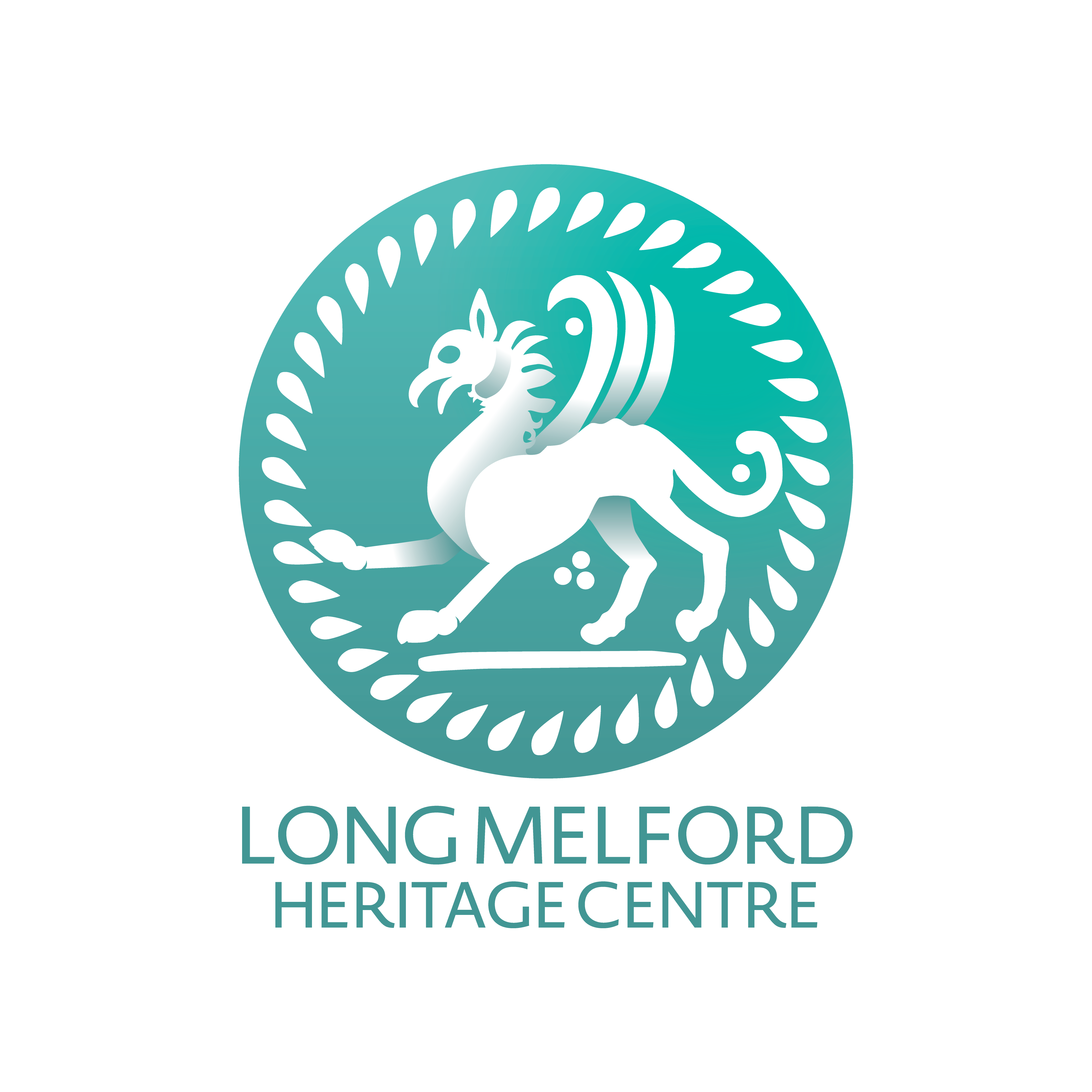





Preface
When I was tidying up in the loft a few months ago, I came across an old toffee tin containing all my Girl Guide badges and some other items. There weren’t any photos in there, but a few had been published on Long Melford Facebook pages, and so I decided it would be a good idea to write about my experiences in the 1960s when 1st Long Melford Guides was formed (for the third time, although I didn’t actually know that then). I had really enjoyed my time in the Guides, and my original idea was to write a short Melford Memories-style reminiscence – a snapshot in time, complete with memories of what it was like to live in Melford then. However, once I had started on this, I discovered that there had been two earlier companies, and I also began to receive material from several other sources. Suddenly my idea took on a life of its own and turned into a history of Guiding in Long Melford, drawn from accounts of Guides and Guiders over the last century. Sarah Boosé has been a major source of material in this respect, and she has worked alongside me in compiling and collating the information received. It would not have been possible to write this history without her collaboration.
While I have been researching this, it really struck me how many girls from Melford remember their time in Guiding with nostalgia and pleasure, and that for some of them, a hobby or interest awakened in Guides has stayed all through their life. I could not have written this history without the help of many other people, listed at the end of this article, and I hope you enjoy reading it as much as I have enjoyed writing it.
Sheila Cadge – June 2023
1 How the Movement began
During the Siege of Mafeking (1899-1900) in the 2nd Anglo-Boer War, Lieutenant-General Robert Baden-Powell saw how young boys were useful for carrying messages for the soldiers. Back in England he decided to try this at a more general level and began by taking 21 boys camping in 1907. The camp was a success, and he followed this up with the book Scouting for Boys. The book covered topics such as tracking, signalling, and cooking, as well as ‘instruction in good citizenship’. Boys (and some girls as well) started forming patrols and troops, calling themselves ‘Boy Scouts’ or ‘Girl Scouts’.
It was not common for girls to go camping and hiking then. The Boy Scouts Headquarters Gazette of 1909 asked: ‘If a girl is not allowed to run, or even hurry, to swim, ride a bike, or raise her arms above her head, how can she become a Scout?’ However, some girls, who refused to accept that Scouting was ‘just for boys’, were registered at Scout Headquarters. In 1909, the first-ever Boy Scout rally took place at Crystal Palace in London. A group of girls from Peckham Rye gate-crashed this event. Following some negative publicity in the press, Baden-Powell decided that a separate, single-sex organisation would be best. His sister, Agnes Baden-Powell, was tasked with organising this, and subsequently in 1910, the Girl Guides Association was formed in the United Kingdom. Soon, these young women began completing badges in sailing, aviation, and home electrics among other things.
There was no Girl Guide company in Long Melford until more than a decade later, a few years after the end of World War 1. During the war women took on many of the traditionally male roles, and Girl Guides were making important contributions to the First World War effort – growing food, acting as messengers for government organisations and working in hospitals, factories, and soup kitchens. Although we know from census returns and many other sources that it was common for young girls to work in factories before they got married, or to move away from home to go into service, the idea of going camping and doing outdoor activities for enjoyment would probably have seemed quite alien. For local girls especially it would have been a very novel, and exciting, experience to go camping without their family for example.
The world and social values had changed hugely at the end of the war, and this change would also have contributed towards the formation of a Guide company in Melford.
2 The early years
According to records from Girl Guide Headquarters, the earliest incarnation of 1st Long Melford Guide Company was in February 1922, with the first registration being on 2nd July 1923. Leaders at the time were Miss E. B. Harris (Captain), Miss Molly Hyde Parker (Lieutenant), and Miss E. L. Sillitoe (Lieutenant). At some point later during this period Miss Maisie Andrews became Captain and Miss Kathleen Deeks Lieutenant.
In 1966, Maureen Baker, who was then Captain, appealed for information about the earlier companies and received this letter from Mrs E. L. Smith [née Sillitoe]: ‘Having seen your appeal in the Parish Magazine for information of past Guide Companies, in the village, the only one I know of was started by Miss Doreen Robinson of Pound Hall, Miss Gertrude Brockwell and myself (Miss Sillitoe). Miss Robinson was captain, but I am sorry to say, not a very energetic one, so the running of the company was left to Miss Brockwell and myself as the two Lts. Mrs Mabel Clover (Mabel Ringer) was a patrol leader, the other names I cannot remember. The girls wore navy cotton tunics and felt hats and pale blue ties. We held a very successful garden fete at Melford Place. As far as I can remember this all happened around 1919-23. I left the village in 1923 and went to Boxford and joined a very good company there, afterwards becoming Brown Owl. No one came forward to help the company here, so it just faded out. I haven’t a photograph and cannot remember how many girls there were. If I can
think of anything more, I will let you know.’
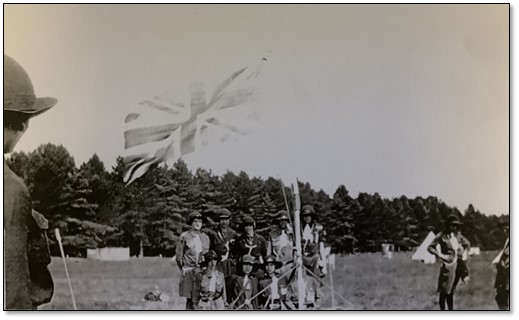
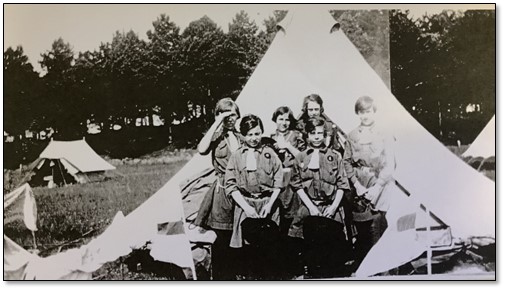
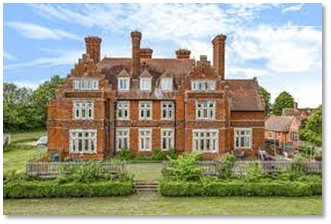
More information surfaced in a letter from Cora Younger (née Woodhouse) written in 1987 in response to a request for information on the occasion of the 75th anniversary of the company’s founding: ‘I can give you a little information of (I think) the first Girl Guide Group in the village around 1924, being one of them. Our Captain was a Miss Bessie Harris, who lived at the Bull Hotel (now Trust House) and a Miss Edith Sillitoe was Vice Captain. In those days we held our weekly meetings at the Parish Room at the Rectory. There was a lapse of a few years when these ladies married, and our next Guide Captain was a Miss Maisie Andrews from Waldingfield & Vice Captain was Miss Kathleen Deeks who lived at High Street Farm. Our meetings were then held at the Institute Rooms at Bull Lane and later at the Club room at the back of the Black Lion; a Miss Molly Hyde Parker from Bulmer, a Miss Stewart from Sudbury, and Miss Banks William from Glemsford were also Senior helpers. We held regular weekend camps at Acton Place by permission of Lady Pearson and our Guide Rallies were held every year at Holbrook Hall Great Waldingfield where our District Commissioner Lady St Leger Glyn lived. I would add that Miss Andrews is now Mrs Whitehouse and lives at The Ferns the Green Long Melford – and Miss Kathleen Deeks is now Mrs Phinney and lives at Greys Close Cavendish – there are still some old Guides living in the village: Phyllis Kemp [née Sansum], Violet Brown [née Sansum], Nellie Pettigrew [née Parmenter], Ethel Drury [née Long], Mary Springett, Cora Younger [née Woodhouse], Florrie Diggins [née Woodhouse] of Sudbury, and Vera Angell [née Woodhouse] of Cavendish. All senior citizens and I don’t think anyone would be able to attend the reunion. We all had some very happy times and can recall our Guiding Days as very useful and rewarding, remembering Once a Guide Always a Guide. Cora, Florrie and Vera were sisters. Cora was born in 1911, so she would have been 11 or 12 when she became a Guide. Cora died in 2007.
This company was disbanded in 1932.
3 1940s and 1950s
The Company was re-formed on 23 August 1948 and registered on 23 June 1949. The then Leader was Mrs Monica Hempstead, who was listed as Lieutenant on 6 September 1949. She is presently 93 years old. Her daughter, Debbie Capon, asked her recently what she remembered about those days, and her mum said she remembered saying Dib Dib Dib, Dob Dob Dob. She also remembered the Guide handshake was with the left hand, as they were told the right hand was used to hold a sword. Her husband Ted used to help with Guide Camps.
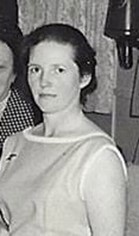
Sarah Boosé has the Guide Handbook which belonged to Marlene Blythe who lived at Melford House, and who remained a family friend until she passed away a few years ago. In the book she writes she was enrolled on 21 September 1948 so must have been one of the first Guides when the Company re-formed for the second time! Sarah says Marlene would have been thrilled to know it was being used in this history.
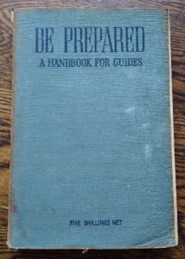
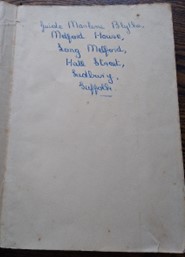
That company lasted eight years and was disbanded on 16 November 1956.
4 1960s – based on the reminiscences of Sheila Cadge
 In the mid-1960s 1st Long Melford Girl Guides came into being for the third time. The company re-formed on 12 January 1965 and was registered on 12 May of that year. When I heard that a Guide Company was being started in Long Melford, I was interested immediately and went along to the first meeting. My ideas of Guiding up to then had come from reading books like Judy, Patrol Leader by Dorothea Moore, which presented a rather more exciting experience of Guiding than we encountered in our meetings. (If I remember correctly,
In the mid-1960s 1st Long Melford Girl Guides came into being for the third time. The company re-formed on 12 January 1965 and was registered on 12 May of that year. When I heard that a Guide Company was being started in Long Melford, I was interested immediately and went along to the first meeting. My ideas of Guiding up to then had come from reading books like Judy, Patrol Leader by Dorothea Moore, which presented a rather more exciting experience of Guiding than we encountered in our meetings. (If I remember correctly, 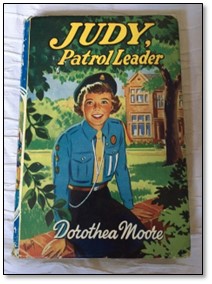 Judy managed to catch burglars and save someone from drowning in the course of the book.) Along with Sue Richardson, Roberta and Linda Nears and Vanessa Ingram, I was a founder member of the re-formed 1st Long Melford Guides in the mid-1960s, which meant that we could choose the names for our two patrols as well as our company scarf colour. There were about 12 of us at that time. We voted to have bright green for the scarf. At that time Guide patrols were named after either flowers or birds. We chose Daffodil (green and yellow shoulder flash for the old shirt-style uniform) and Fuchsia (maroon and dark blue) for the two patrols. (I would rather have had bird names and been a Swallow, but I was outvoted and ended up in Fuchsia patrol.) I eventually became Patrol Leader for Fuchsia. Maureen Baker from High Street was our Captain, and Ruth Nears (Roberta and Linda’s mum), who lived in Church Row, was our Lieutenant. They had never been Guiders before, so it was very much a case of everyone learning as we went along. Because we were forming the company from scratch, none of the girls had previous experience as Guides, and so four girls were chosen to become patrol leaders and seconds. We then all studied for the Tenderfoot test together so that we could be formally enrolled as Girl Guides. Among other things we had to: attend meetings regularly for at least a month; learn about the traditions and history of the movement; learn whistle and hand signals, basic knots (including how to tell a granny from a reef knot); know about the composition of the Union Jack and the right way to fly it (I automatically check flags even now to make sure they are the right way up); and finally (oh, the joys of being a girl in the mid-twentieth century) how to strip and make a bed. At the enrolment ceremony the threefold promise we made was as follows: A Guide promises on her honour that she will do her best, To do her duty to God and the Queen, To help other people at all times and To obey the Guide Law. We saluted and received our Tenderfoot badge in the form of a trefoil, which had to be polished with Brasso before every meeting as it tarnished really easily.
Judy managed to catch burglars and save someone from drowning in the course of the book.) Along with Sue Richardson, Roberta and Linda Nears and Vanessa Ingram, I was a founder member of the re-formed 1st Long Melford Guides in the mid-1960s, which meant that we could choose the names for our two patrols as well as our company scarf colour. There were about 12 of us at that time. We voted to have bright green for the scarf. At that time Guide patrols were named after either flowers or birds. We chose Daffodil (green and yellow shoulder flash for the old shirt-style uniform) and Fuchsia (maroon and dark blue) for the two patrols. (I would rather have had bird names and been a Swallow, but I was outvoted and ended up in Fuchsia patrol.) I eventually became Patrol Leader for Fuchsia. Maureen Baker from High Street was our Captain, and Ruth Nears (Roberta and Linda’s mum), who lived in Church Row, was our Lieutenant. They had never been Guiders before, so it was very much a case of everyone learning as we went along. Because we were forming the company from scratch, none of the girls had previous experience as Guides, and so four girls were chosen to become patrol leaders and seconds. We then all studied for the Tenderfoot test together so that we could be formally enrolled as Girl Guides. Among other things we had to: attend meetings regularly for at least a month; learn about the traditions and history of the movement; learn whistle and hand signals, basic knots (including how to tell a granny from a reef knot); know about the composition of the Union Jack and the right way to fly it (I automatically check flags even now to make sure they are the right way up); and finally (oh, the joys of being a girl in the mid-twentieth century) how to strip and make a bed. At the enrolment ceremony the threefold promise we made was as follows: A Guide promises on her honour that she will do her best, To do her duty to God and the Queen, To help other people at all times and To obey the Guide Law. We saluted and received our Tenderfoot badge in the form of a trefoil, which had to be polished with Brasso before every meeting as it tarnished really easily.
5 Uniform and Patrols
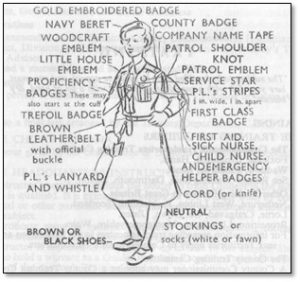
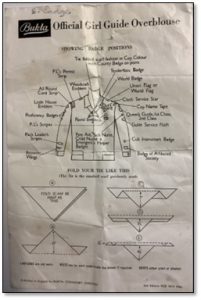 The uniforms we wore were old-style to start with, although the beret was no longer worn. (You can see from the pictures that we are wearing a mixture of the old and new style uniforms). Instead, we had an ‘air hostess’ style hat which didn’t always stay on your head easily. Along with a navy gored skirt we wore a blue shirt with our company name and flashes sewn on the shoulder – as I mentioned before, these were maroon and blue for Fuchsia, and yellow and green for Daffodil. The tie was actually a big piece of material which could double as a triangular bandage. We had to fold it a specific way to make a tie to go round the neck of the shirt, and it was fastened with a reef knot at the back. The shirt was tucked into the skirt, and we wore tights or socks (we never wore trousers for regular meetings, only for activities such as camping). Badges had to be sewn on the shirt in specific places, e.g., the patrol badge was above the left pocket, and proficiency badges were sewn down the sleeve. Patrol leaders and seconds both wore lanyards with whistles attached, while patrol leaders had two stripes of white tape down their left pocket, seconds only had one. The uniform changed over to the new style around 1967 to 1968. The main difference was the shirt, which now had three-quarter length sleeves and was worn outside the skirt, and the way all the attached paraphernalia and badges were displayed. The tie became a neckerchief and lanyards were no longer worn (to my great sadness). Stripes for Patrol Leader and Second now became a badge worn under the patrol name badge, and the shoulder flashes were no longer used. I seem to remember we bought the shirts from Winch and Blatch, but all the badges etc were ordered through our Captain. All the insignia now went in different places on the shirt, and we were issued with a leaflet to make sure we sewed them on correctly. For some reason I never threw mine away, this might jog a few memories.
The uniforms we wore were old-style to start with, although the beret was no longer worn. (You can see from the pictures that we are wearing a mixture of the old and new style uniforms). Instead, we had an ‘air hostess’ style hat which didn’t always stay on your head easily. Along with a navy gored skirt we wore a blue shirt with our company name and flashes sewn on the shoulder – as I mentioned before, these were maroon and blue for Fuchsia, and yellow and green for Daffodil. The tie was actually a big piece of material which could double as a triangular bandage. We had to fold it a specific way to make a tie to go round the neck of the shirt, and it was fastened with a reef knot at the back. The shirt was tucked into the skirt, and we wore tights or socks (we never wore trousers for regular meetings, only for activities such as camping). Badges had to be sewn on the shirt in specific places, e.g., the patrol badge was above the left pocket, and proficiency badges were sewn down the sleeve. Patrol leaders and seconds both wore lanyards with whistles attached, while patrol leaders had two stripes of white tape down their left pocket, seconds only had one. The uniform changed over to the new style around 1967 to 1968. The main difference was the shirt, which now had three-quarter length sleeves and was worn outside the skirt, and the way all the attached paraphernalia and badges were displayed. The tie became a neckerchief and lanyards were no longer worn (to my great sadness). Stripes for Patrol Leader and Second now became a badge worn under the patrol name badge, and the shoulder flashes were no longer used. I seem to remember we bought the shirts from Winch and Blatch, but all the badges etc were ordered through our Captain. All the insignia now went in different places on the shirt, and we were issued with a leaflet to make sure we sewed them on correctly. For some reason I never threw mine away, this might jog a few memories.

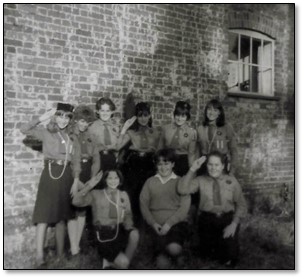
6 Where and when we met based on the reminiscences of Sheila Cadge
As I remember we met on Tuesday nights. Our meetings took place ln what had been the old Arnold and Gould horsehair factory. We shared this building with other youth associations. To get there you went down an alleyway between the Old House restaurant (passing the kitchens, often with lovely smells wafting out of the building) and the Co-op, and through an old orchard. It was also possible to get to it from round the back of St Catherines Road at that time. You would never be allowed to have young people meeting in a place like that today, we were warned not to go upstairs, as the stairs and floor weren’t safe. The upstairs was usually out of bounds although apparently there were a couple of heavy medicine balls stored up there that were used occasionally for exercises (however I can’t remember that personally). The wooden floors were quite uneven, and there were cobwebs in every corner of the ceiling. It was very cold there in the wintertime, with single glazed windows that iced up inside. There was a deactivated WW2 bomb hanging from the ceiling, which had been presented to the Scouts from USAF Sudbury. The factory grounds backed on to the lane and allotments by the side of Chad Brook, continuing round from Cock and Bell Lane. The lane became a footpath over to the allotments on the other side of the footbridge (there were far more allotments along there at that time than there are today, and there were always lots of people there during the growing season), and we sometimes went to the bridge across the stream. More often than not Ephraim Younger would be somewhere around, as not only did he have plots of his own there, but he was responsible for the allotment rents etc. We actually ranged all over the centre of Melford, down the back to the football field and round St Catherines Road when we were tracking or practising Scouts’ Pace during the long summer evenings. (One of the highlights of going to Guides was buying chips with scraps from the chip shop on the way home – wrapped in newspaper, of course. They always tasted so good!)
7 Activities – based on the reminiscences of Sheila Cadge
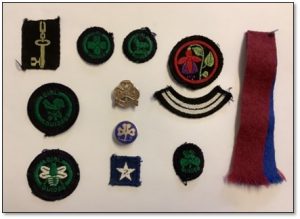 During sessions we would do a variety of activities related to completing our 2nd Class syllabus and achieving badges, as well as games. (You can see from the photo of my (rather battered) test card here that I completed my 2nd Class test. We practised making phone calls from the phone boxes in Hall Street and at the top of Woollards Gardens, often having to take a break or give up because hardly any people had phones in their houses then, and so you could end up queuing for your turn. For an ordinary phone call, you needed to put in 4d in old pennies, dial the number and press Button A when someone answered, or Button B if there was no response, to get your money back. We practised dialling 999 for emergency services when it was dark by wearing a blindfold. (Find the dial and the finger holes, move your end finger one along, keep it there and turn the dial three times) I’m sure this must have been of use to somebody at some point, although fortunately I never had to use this knowledge. We built fires in the old orchard and cooked sausages, and damper bread on a stick (more than once resulting in indigestion!). We also practised square lashing, ending up with wobbly seats and shelves, neither of which I would have trusted to bear much weight. We were allowed to choose to a certain extent which proficiency badges we wanted to do, depending on whether testers were available for some of the more specialist ones. Along with my second class badge I completed First Aid, Child Nurse, Weatherman and Thrift badges. The Weatherman badge (green weathercock) was quite an easy one as we had covered nearly all of the syllabus in Geography at school. We had to keep a daily record of weather for one month as well as being able to describe various types of weather and make either a simple rain gauge or a wind vane and know how to use it to obtain reasonably reliable records. Nothing about global warming in those days. For my Thrift badge (green bee), among other things, I had to show that I had a savings account, bring a certificate from my parents stating that I was not wasteful in the home, and that I was keeping my clothes in good condition. Like many Melford families at that time, being thrifty was a way of life. Mum made most of our clothes, we very rarely bought anything from a shop. Dad grew all our vegetables and soft fruit, we went foraging for blackberries in the autumn, and Mum made jams and chutneys as well as ‘doing down’ eggs. This entailed buying eggs in summer when they were cheaper and dipping them in isinglass so that they lasted into the winter. The trays of eggs were stored on top of the wardrobe and used as needed for baking. In addition, I had to produce an article that proved I was thrifty. This was quite easy for me as my aunt Cookie Boreham worked in a silk factory in Welwyn Garden City and she used to save me scraps of brightly coloured material. I padded coat hangers with foam and covered them with silk on top, and I made a patchwork quilt for a doll’s cot. I also completed Child Nurse, a test which applied throughout to children of 3 to 5 years. The first part of the test involved general principles and common-sense knowledge, starting with: The candidate must have a sense of responsibility and a high standard of personal cleanliness; she must understand that when dealing with a child she must carry out whatever she has said that she will do, and must never resort to bribery. The second part of my test was taken under the supervision of Valerie Theobald, who had trained as a nursery nurse. I looked after her son, Peter, for an afternoon at Hanwell House, and had to take care of him while he was playing, tell him a story, and plan and prepare a meal for him. Obviously, I must have met with Valerie’s approval, as I passed this part of the test.
During sessions we would do a variety of activities related to completing our 2nd Class syllabus and achieving badges, as well as games. (You can see from the photo of my (rather battered) test card here that I completed my 2nd Class test. We practised making phone calls from the phone boxes in Hall Street and at the top of Woollards Gardens, often having to take a break or give up because hardly any people had phones in their houses then, and so you could end up queuing for your turn. For an ordinary phone call, you needed to put in 4d in old pennies, dial the number and press Button A when someone answered, or Button B if there was no response, to get your money back. We practised dialling 999 for emergency services when it was dark by wearing a blindfold. (Find the dial and the finger holes, move your end finger one along, keep it there and turn the dial three times) I’m sure this must have been of use to somebody at some point, although fortunately I never had to use this knowledge. We built fires in the old orchard and cooked sausages, and damper bread on a stick (more than once resulting in indigestion!). We also practised square lashing, ending up with wobbly seats and shelves, neither of which I would have trusted to bear much weight. We were allowed to choose to a certain extent which proficiency badges we wanted to do, depending on whether testers were available for some of the more specialist ones. Along with my second class badge I completed First Aid, Child Nurse, Weatherman and Thrift badges. The Weatherman badge (green weathercock) was quite an easy one as we had covered nearly all of the syllabus in Geography at school. We had to keep a daily record of weather for one month as well as being able to describe various types of weather and make either a simple rain gauge or a wind vane and know how to use it to obtain reasonably reliable records. Nothing about global warming in those days. For my Thrift badge (green bee), among other things, I had to show that I had a savings account, bring a certificate from my parents stating that I was not wasteful in the home, and that I was keeping my clothes in good condition. Like many Melford families at that time, being thrifty was a way of life. Mum made most of our clothes, we very rarely bought anything from a shop. Dad grew all our vegetables and soft fruit, we went foraging for blackberries in the autumn, and Mum made jams and chutneys as well as ‘doing down’ eggs. This entailed buying eggs in summer when they were cheaper and dipping them in isinglass so that they lasted into the winter. The trays of eggs were stored on top of the wardrobe and used as needed for baking. In addition, I had to produce an article that proved I was thrifty. This was quite easy for me as my aunt Cookie Boreham worked in a silk factory in Welwyn Garden City and she used to save me scraps of brightly coloured material. I padded coat hangers with foam and covered them with silk on top, and I made a patchwork quilt for a doll’s cot. I also completed Child Nurse, a test which applied throughout to children of 3 to 5 years. The first part of the test involved general principles and common-sense knowledge, starting with: The candidate must have a sense of responsibility and a high standard of personal cleanliness; she must understand that when dealing with a child she must carry out whatever she has said that she will do, and must never resort to bribery. The second part of my test was taken under the supervision of Valerie Theobald, who had trained as a nursery nurse. I looked after her son, Peter, for an afternoon at Hanwell House, and had to take care of him while he was playing, tell him a story, and plan and prepare a meal for him. Obviously, I must have met with Valerie’s approval, as I passed this part of the test.
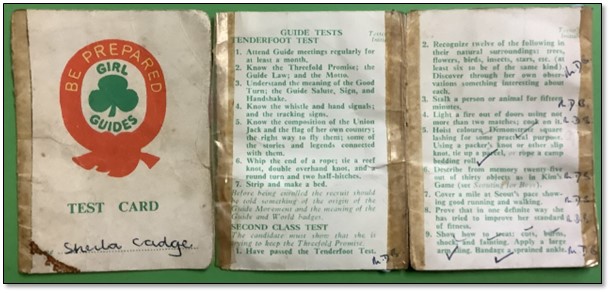
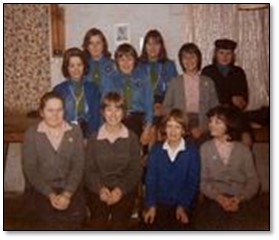
One of the highlights of being a Guide is going camping, and I vividly remember going to Tendring Hall Park near Stoke by Nayland for a District camp in the Whitsun school holidays, when the rhododendrons were in glorious bloom. I had never seen such beautiful flowers! We were accommodated in old-style heavy canvas army tents, with a cook tent as well, and a lot of the activities focussed around keeping everything very tidy, and campfires. We cooked, sang classic Guiding songs (not exclusive to us) such as Ging gang goolie, She’ll be coming round the mountain, and the Hearse Song (Don’t laugh if you see a hearse go by.). The weather was not the best, damp and rainy at times, and we all went home tired from lack of sleep, gnat-bitten and smelling of woodsmoke.
Vanessa Ingram also remembers the short camp at Tendring, but, along with several other Melford Guides, she went on a two-week camp in Thetford Forest in the mid ‘60s. Among their outings were trips to Norwich Castle and Grimes Graves. As the camp lasted two weeks, Vanessa’s family (and possibly other girls’ families as well, judging by the pictures) came to visit at the weekend. On the left of this photo you can see, among others, her parents and Grandad Moyle, and Linda Nears and Ardyn Smith on the right of the tent. There was a stream which they used for various activities, but unfortunately there were also a lot of mosquitoes, and Vanessa went home with poison legs from all the bites. No one had insect repellent or after-bite ointment with them then. Not a very happy souvenir!
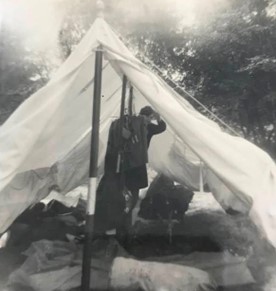
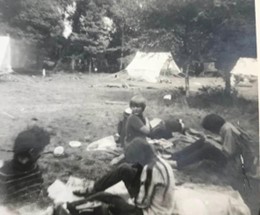
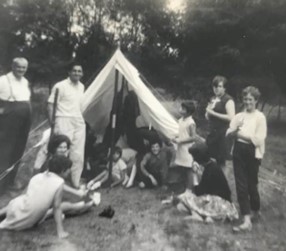
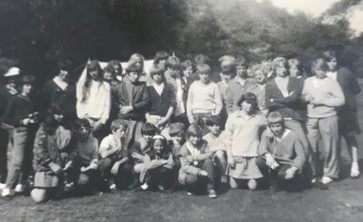
8 Occasions – based on the reminiscences of Sheila Cadge
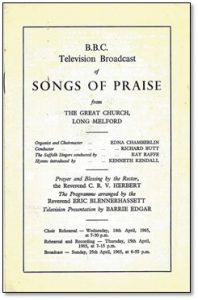 Songs of Praise in April 1965 – This was a huge event for the village, people were talking about it for weeks beforehand and hoping to get tickets. The Guides attended as one of the village organisations. On this picture you can also see representatives of the Cubs and Scouts, Sunday School children and nursing staff from Montgomery House, which was run by Dr Barnardo’s at that time. We had to make sure our uniform was totally correct, and there was a rehearsal as well as the actual recording. All this took quite a long time because the seating plan had been worked out in advance, we were shoehorned in, and then we rehearsed the programme to make sure everyone knew what they were doing. I remember watching the TV broadcast (which I am sure is lost now, but which I would love to see again), and looking out for everyone I knew. I was also quite awestruck at seeing Kenneth Kendall, a BBC newsreader, in real life. My gift to posterity was a single shot where I am rolling my eyes heavenward before the camera focused on someone in the row behind me.
Songs of Praise in April 1965 – This was a huge event for the village, people were talking about it for weeks beforehand and hoping to get tickets. The Guides attended as one of the village organisations. On this picture you can also see representatives of the Cubs and Scouts, Sunday School children and nursing staff from Montgomery House, which was run by Dr Barnardo’s at that time. We had to make sure our uniform was totally correct, and there was a rehearsal as well as the actual recording. All this took quite a long time because the seating plan had been worked out in advance, we were shoehorned in, and then we rehearsed the programme to make sure everyone knew what they were doing. I remember watching the TV broadcast (which I am sure is lost now, but which I would love to see again), and looking out for everyone I knew. I was also quite awestruck at seeing Kenneth Kendall, a BBC newsreader, in real life. My gift to posterity was a single shot where I am rolling my eyes heavenward before the camera focused on someone in the row behind me.
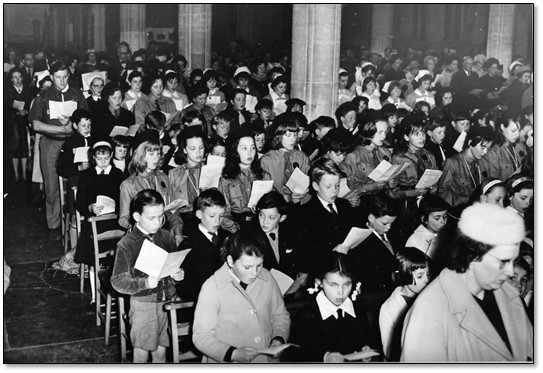
St George’s Day Parade – The newspaper clipping below gives more information about the service, which was conducted by our lovely Reverend Herbert. (I never attended this, as I was on my way back from a joint school exchange with Haverhill Secondary School to Pont St Esprit, their twin town in Provence.)
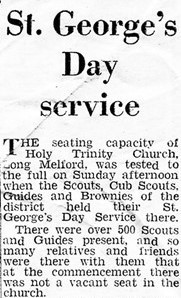
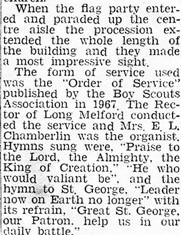
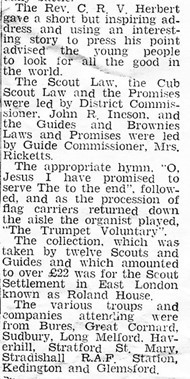
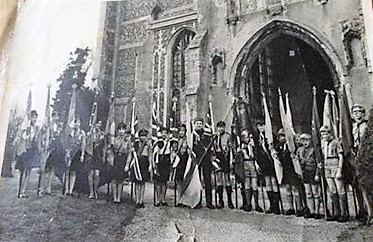
Remembrance Day – I was the standard bearer for the Guides for Remembrance Day in 1967. We assembled at Hanwell House outside the post office and processed up to the church. At that time World War 1 veterans would have been in their mid-sixties or older, and several of them joined in the procession, along with many Second World War veterans.
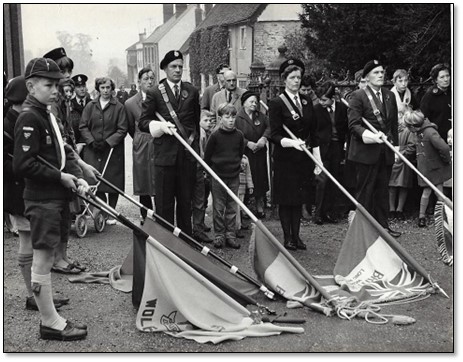
9 What came next – based on the reminiscences of Sheila Cadge
At that time, it was possible to leave school at 15, or stay on and take GCE ‘O’ levels or CSEs, and so, due to a mixture of workload from school and the fact that I knew I would never get my 1st class badge, as I would never manage to swim 50 yards, (which was a huge discouragement for me to continue) I left around the end of 1967. I always had fond memories of my time as a Girl Guide, and also encouraged my daughter to join (although not in Melford, as I had gone to live up north after university). By a strange coincidence, when I was teaching, I taught the three girls from Wark, in Northumberland who were the first girls admitted to the Scouts at the end of last century, heralding a sea change in the movement. When Vanessa left Guides, she went on to help with the Brownies but unfortunately her job in catering put a stop to that. Sue can’t really remember why she stopped going, but reckons she probably discovered the youth club and boys.
10 1970s – based on the reminiscences of Sarah Boosé
The first ‘Scout and Guide Hut’ after the old factory building, was actually located where the present hut stands today, on land owned by the Hyde Parker estate in Smaley Lane. Fund raising for that hut, and for its improvement and maintenance, was organised by the ‘Friends of the Group’ (FOGS), a group of parents and other interested parties with Leaders as ex officio members who organised dances, jumble sales, raffles etc. and indeed raised a lot of money. One big fund-raising event was “The Guide and Scout Great Day Out!” when we used the whole of the bottom green facing Melford Hall. All the groups, Guides, Scouts, Brownies, and Cubs, plus the District Ranger Unit, put on displays throughout the day plus stalls, food and so on. This committee in later years became known as the Headquarters Management Committee when things were put on a more legal footing and to comply with both Scout and Guide Property rules, which were totally different from each other. It was a long wooden building and was bought second-hand, having been the site HQ when they built the Springlands Estate in Sudbury. I know my parents and many others were involved in the fundraising to buy and equip it, and parents with building skills did the actual construction. It came into use in the early 1970s. All the groups were present at the opening ceremony. It was one long hall with a small kitchen, entrance hall and two toilets at the end. The layout was very much as it is today, it had a tiled floor and overhead small fan heaters and was very cold in the winter. At some point the floor rotted and we all met elsewhere whilst repairs were being carried out. I remember the Guides meeting in the Library at the URC in 1973, and doing our First Aid badges there (we all passed!) with a St. John’s Ambulance Service volunteer who attended our meetings for a few weeks. We used the large hall at the URC for concerts etc. as it was bigger and had a stage as well. Later more fundraising took place to build a ‘Quiet Room’ on the back and then a separate store building for equipment etc. was added behind that. Very little has changed other than the building has been upgraded somewhat and is a lot more comfortable and warmer. I moved from 1st Long Melford Brownies to the Guide Company in September 1969. The Company still met at the old HQ behind the Co-op, with Maureen Baker and Ruth Nears as Leaders.
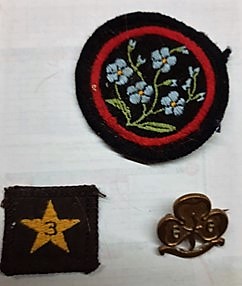
1968 saw major changes in Guiding for all sections, with the introduction of the Eight Point programme replacing First and Second-Class Tests. Uniforms changed too, with Guides wearing a long-sleeved shirt over their skirts, crossover tie and air hostess style hats. It was very much an era of mix and match as I had the new shirt but still the small neckerchief with a blue woggle (which kept falling off and getting lost!!) until the small crossover tie fastened with Promise badge became available. Long Melford still wore bright green ties and had Snowdrop, Daffodil, White Rose and Forget Me Not patrols. (Fuchsia Patrol emblems were stopped by Guide HQ in 1966 but they were still being worn in the later 60s in our Company.)
I was in Snowdrop Patrol to start with. Other girls in my Patrol were Judy Cadge (PL), Ann Morton (PS), Helen West, Philippa Monnington (from Foxearth, whose sister Paula was also in the Company) and my friend Liz Mowle. We practised semaphore in the orchard behind the hut, played rounders and other ball games and cooked on campfires. We attended Remembrance Sunday parade in Long Melford Church. Summer camp in 1970 was held at Stanningfield Rectory as the rector’s wife was involved with Guiding. I didn’t go as I had the choice of this or a school trip which I chose. Maureen Baker gave up the Company (which then totalled nine girls) and it was taken over by Beryl Hogger and Margaret Tinworth. As numbers grew, I was made PS of a new Patrol, Scarlet Pimpernel, before moving to become PL of White Rose where I remained until I left Guides. As mentioned, on her ‘retirement’ from running the Company in 1971 Maureen Baker ran the Ranger Unit in Sudbury. Ruth Nears helped Elsie Woodhouse with the 1st Long Melford Brownies until she emigrated to Tasmania. From 1971 – 1981 the Guide Guider was Mrs. Beryl Hogger, with Assistant Guide Guiders Mrs. Margaret Tinworth and Mrs. Sue Morris (1973 -1975). In 1971, aged just 12, I carried the Company Colour at the District Thinking Day Service in St Peter’s Church in Sudbury – not because I was specifically chosen but because no one else would do it! No one showed me how to carry the Colour, and when it came to dipping for the National Anthem at the rehearsal, I veered to one side and hit the then District Commissioner Mrs. Holman on the head as she sat in the choir stalls. Luckily, she was very understanding and showed me how to do it properly. I didn’t make that mistake again! Summer camp in 1971 was a joint one with 1st Clare Guides held at Chadacre Agricultural Institute. None of us ever forgot the Hungarian Goulash with bread and butter, and jelly made in a washing up bowl which we had to drink as it didn’t set.
The photo below was taken around 1969 at a fundraiser event towards getting new premises; you can clearly see the state of the building being used, and why this was necessary. The staircase leading upstairs is at the back of the image.
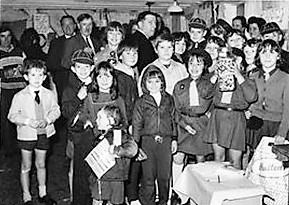
In May 1971, I started helping out at Brownies to gain my Service Flash, and never left. I became Pack Leader, then a Young Leader, Assistant Brownie Guider and then took over the pack at just 18 years old when Elsie Woodhouse retired. I ran the Pack until the year 2000. We had moved to the new HQ next to the Village Hall by then. Autumn half term saw us going to London to visit Guide HQ in Buckingham Palace Road and the Commonwealth Institute. We gave a Christmas concert for family and friends. My highlights of 1972 were attending a County Patrol Leaders’ training day at Kesgrave. For the Keep Fit section of my Green Trefoil (2nd Year badge) I walked to Stanstead and back, keeping a log with two friends, Julie Austin and Carolyn Palmer, who were also Guides. Patrol Leaders’ weekend camp took place in the Rectory Meadow and our summer camp was at Tiger Hill, Assington. We had plenty of space on the grass behind the Village Hall for outdoor activities and I have vivid memories of practising tent pitching and making gadgets out there before summer camps! We also had a company outing to Kew Gardens and Richmond Ice Rink, where we found skating was not as easy as it looked!
Bell-Ringing – One of my fellow Guides, Linda Johnston, first started an activity in Guides in 1972, which has become a lifelong interest spanning over fifty years. She explained how it all started: ‘Sylvia Johnston, Mary Rutherford and I were Girl Guides and Sylvia and I both got into it to obtain a Girl Guide hobby badge. By this time Mary and I were both 16 and Sylvia was 14. I began and completed my badge in 1972, Sylvia and Mary both began and completed in 1974. Tina Cadge, the ringer in the right bottom corner of the picture below, also learnt to ring in 1974, at the same age as Mary and me, but I can’t remember if she joined us as a Guide or just because she wanted to ring.’ In this image you can see the three Girl Guides: Sylvia Johnston (on box left side), Mary Rutherford (in white), Linda Johnston (on the lighter box).’
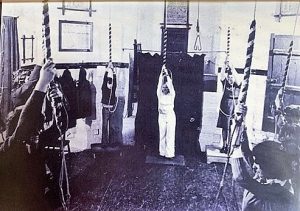
Linda Goodban is now Tower Captain at Holy Trinity Church Long Melford, and continues to encourage people to take up campanology.
I (Sarah) attended another PL’s Training at Kesgrave in 1973, and District Thinking Day celebrations were held in the new Long Melford HQ. Patrol Leaders weekend camp was at Tiger Hill Assington before summer camp at Old Buckenham Hall School, Brettenham where I (amazingly) won the Best Camper Award. I also remember going on a cycle ride around Borley and the Belchamps- imagine letting girls go off and do that now! (Health and Safety has certainly changed over the last 50 years!). In November I completed the syllabus for the Queen’s Guide Badge. It was presented on 11th December, at a parents’ event at the URC Hall where we were meeting, as the Guide Hut was undergoing repairs. I was the first Guide in Long Melford to achieve this. It was customary to have your picture taken and the award mentioned in the Suffolk Free Press, as it was such an achievement, but I declined this (which I now regret) as I thought I would be mocked at school for still being a Girl Guide. How wrong I was, as people asked if I ever got my Queen’s Guide badge. In 1974 White Rose Patrol gave a tea party for the over 60s Club as our Easter Good Turn, and I went on my last summer camp at Stutton Hall, where we had a guided tour of HMS Ganges and a boat trip across to Harwich and Dovercourt, as well as our own private beach on the banks of the river Stour. I left the company that summer, but I continued in Guiding with the Brownies.
11 1980s and 1990s – includes reminiscences from Sarah Boosé
I also returned as a helper at Guides Summer Camps (mainly assisting Margaret Tinworth as QM) and helped at other events. In August 1991 the Guide and Scout Great Day Out fundraiser was held, where we had exhibitions in the Old School as well as activities on the Green. In later years I became District Commissioner for the then Clare District and 1st Long Melford was one of the Companies in my care. In 1985 I was lucky enough to be chosen to represent Suffolk at the Flame Lighting Ceremony, which was carried out by our then President Princess Margaret on the forecourt of Buckingham Palace, to mark the 75th Anniversary of the Girl Guide Movement. This flame was then carried through every region round to every individual Guiding unit, so everyone in Guiding shared it. Now, along with Margaret Tinworth, I am County Archivist for Girlguiding Suffolk. We have in our care photos, logbooks and other items of the company from the 1970s onwards, including the standard shown in the 1960s images along with a later one. Both flags are properly rolled, wrapped etc, and kept with, sadly, a lot of others from now disbanded companies.
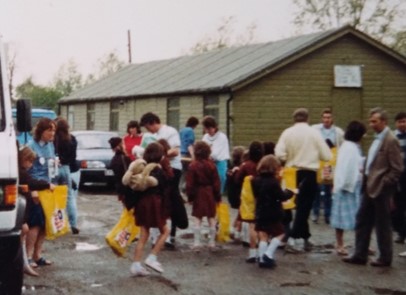
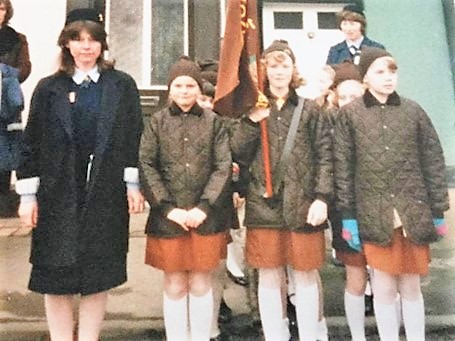

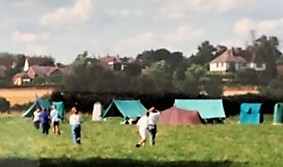
From 1981 – 2002 the company was led by Mrs Carole Bowen with help from Assistant Guide Guider Mrs Ruth Taylor. Kate Richardson was also involved for a short while around 1991 before moving from the area.
75 Year Reunion – In 1997 Long Melford Guides (under Leaders Carole Bowen and Ruth Taylor) held a celebration of 75 years of Guiding in Long Melford (albeit not continuous) in 1997 when former members of the Company from all eras gathered. Molly Steward, who is now 84, travelled from Ipswich to represent the first batch of girls to sign up for the Guides in the village when she was just 11 years old. Former Guide leader Molly Hyde Parker, who now lives in London, was not well enough to travel to the 75th anniversary celebrations. Instead, she sent a message of congratulation. This meant that all leaders who had been associated with the group since its formation took part in the day in some form. They included Beryl Hogger (1979-81) who travelled back from Portugal for the event. Margaret Tinworth, now of Lavenham, was also a leader at the time. She took along her collection of old Guiding uniforms, including one dating back to 1910. The celebrations, which were held on Saturday afternoon, were organised by the present Guide leader Carol Bowen. They were attended by about 70 people and were staged at the Guide and Scout Hut. Activities and events to mark the landmark occasion included an exhibition of photographs and other records, a celebration tea, and a campfire. (Miss Molly Hyde Parker was among the previous Guiders mentioned in the article. She was Sir Richard’s first cousin once removed, and her death was registered in the Sudbury registration district in 1998, not long after that 75th anniversary celebration.)
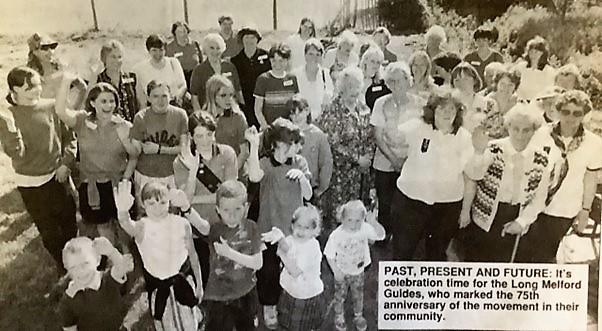
12 2000 to the present day – By the new millennium it had become evident that a new building was needed for Scout and Guide H.Q. Carolyn Spraggons, who is the current Beaver Scout Leader (22 years and counting), Catherine Perryman, Karen Austin, and Claire Ingram formed a committee and fundraised for seven years to raise around £78,000 to rebuild the H.Q. Philip Windsor was the management committee Chair person, and Lynne Windsor was the Guide Guider at that time. Fundraising was across all youth groups and included among other events quiz nights, snail races, book sales, jumbles, litter picks, and sponsored events. In Carolyn’s own words: ‘It was a bit of a slog’. To save money the group knocked the old building down themselves. Some of the timbers were re-used in the country park, and the wood was also used to fuel the Big Night Out bonfire at Melford Hall that year. The footprint was exactly the same as the previous building. as the same brick base was used. A better heating system, insulation and cladding were installed. The outer doorways were in exactly the same place, with a disabled access ramp added to the double doors on the front replacing the steps. At a later date the same committee raised a further £18, 000 to rebuild the stores. The open day for the new building was 13 May 2011. The inside featured displays of the organizations’ histories, and Sarah, who had always been interested in the history of Guiding, put together with a display of uniforms, badges, scrapbooks etc. showing Guiding through the ages which filled the Quiet Room.
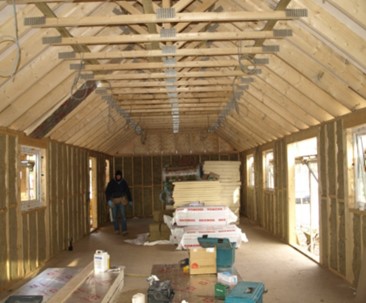
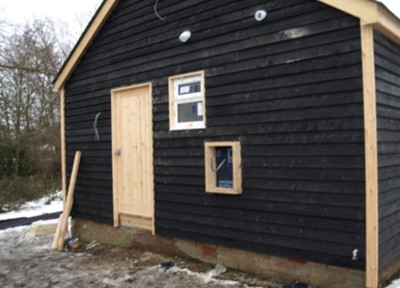
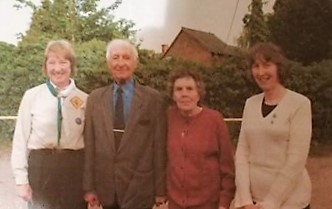
Mrs Lynne Windsor was Leader in Training from 2001 and took over as Guide Guider with parent helpers from 2003 to 2013, followed around 2012 by Mrs Diana Nice with Mrs Trudie Wright. Trudie Wright then took over the running of the company from September 2014. In 2014 it was decided that the Company should replace the standard used since the ‘60s. A service was held for the dedication of the new standard, and at the suggestion of the Reverend Matthew Lawson the old flag was flown one final time from the tower flagpole then lowered and replaced with the new one – a touching moment!
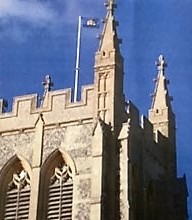
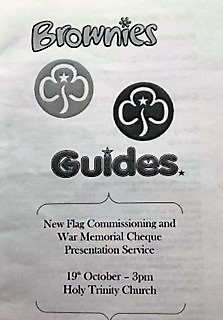
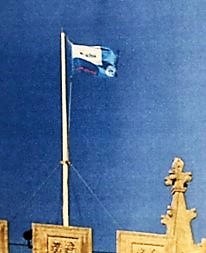
Trudie Wright was the final Guide Guider until she was unable to find anyone willing to assist her. (At some point during this era Amanda Rowbotham assisted with the company, and Carrie-Anne Nice was Assistant Leader from November 2014 to January 2017.) Sadly 1st Long Melford Guides then closed on 14 December 2018, followed by 1st Long Melford Brownies on 29 January 2020.
Postscript: There is now a company of Girl Guides in the village again, meeting weekly in the Scout and Guide H.Q., but they are no longer called 1st Long Melford Girl Guides. The 1st Chadbrook Guides was formed in 2021. They are a District Company who take girls from the whole area, and who meet in Long Melford.
Acknowledgements – Thanks to the following for their contributions and help: Vanessa Ascott, Hazel Bell, Lyn Boothman, Helen Brabner, Debbie Capon, Maureen Clayton, Melonie Clubb, Linda Goodban, Monica Hempstead, Pauline Horne, Amy Hyde Parker, Geraldene Mason, Roberta Le Plastrier, Sue Smith, Carolyn Spraggons, Ann Wegg, Terry Woodhouse, 1st Long Melford Scout & Guide H.Q., John Nunn & Long Melford Museum and Heritage Centre, Keith Slater & Long Melford Historical and Archaeological Society, Girlguiding Suffolk archives and website, Leslie’s Guide interest badge website, Melford Matters Issue 6, Suffolk Free Press and Wikipedia.
Apologies for any omissions
| Cookie | Duration | Description |
|---|---|---|
| cookielawinfo-checkbox-analytics | 11 months | This cookie is set by GDPR Cookie Consent plugin. The cookie is used to store the user consent for the cookies in the category "Analytics". |
| cookielawinfo-checkbox-functional | 11 months | The cookie is set by GDPR cookie consent to record the user consent for the cookies in the category "Functional". |
| cookielawinfo-checkbox-necessary | 11 months | This cookie is set by GDPR Cookie Consent plugin. The cookies is used to store the user consent for the cookies in the category "Necessary". |
| cookielawinfo-checkbox-others | 11 months | This cookie is set by GDPR Cookie Consent plugin. The cookie is used to store the user consent for the cookies in the category "Other. |
| cookielawinfo-checkbox-performance | 11 months | This cookie is set by GDPR Cookie Consent plugin. The cookie is used to store the user consent for the cookies in the category "Performance". |
| viewed_cookie_policy | 11 months | The cookie is set by the GDPR Cookie Consent plugin and is used to store whether or not user has consented to the use of cookies. It does not store any personal data. |
